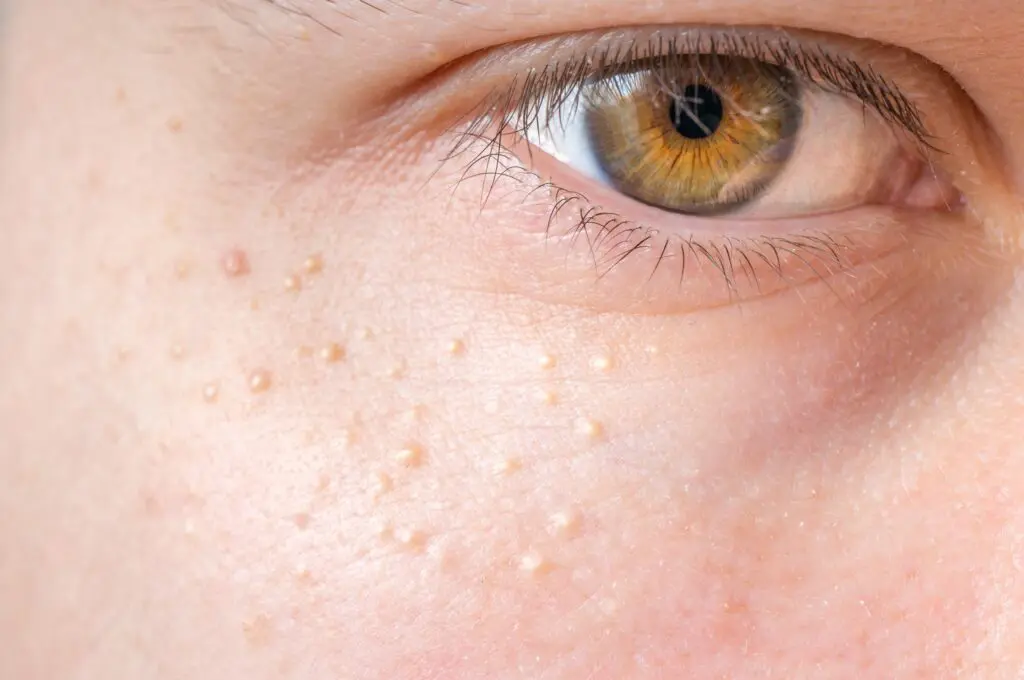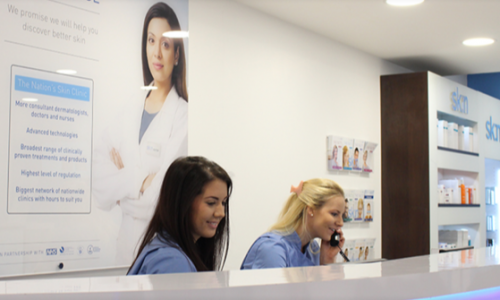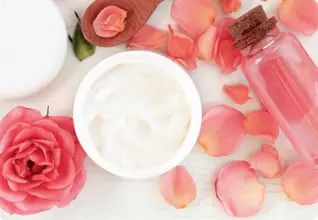How to get rid of milia

Medically Reviewed June 2023, by Daron Seukeran, Group Medical Director, for sk:n. Next review due June 2024.
Milia are small white or yellowish raised cysts, bumps or spots on the skin. They are normally found around the eye area and cheeks, but can appear anywhere on the face or body.
Unlike a pimple or spot, milia feel quite hard and do not have any redness or inflammation as you might expect with whiteheads or acne-related spots. Milia are not contagious or harmful in any way, but some people may feel self-conscious about them, especially if they are on an area of the skin which is very visible, such as the face. Milia can sometimes take a long time to disappear naturally, but can be professionally removed through a simple, minor procedure that we provide here at sk:n.
Types of Milia
There are five main types of milia:
Neonatal milia
Neonatal milia or ‘milk spots’ are milia found on newborn babies. It is thought they are caused by sweat glands that haven’t fully developed yet and so become blocked easily.
Primary milia
Primary milia can appear on children or adults. They can disappear without treatment, but tend to last longer in adults and can often be permanent.
Secondary milia
These occur in areas after injury or trauma. It is thought that this is due to damage caused to the sweat glands in the affected area of skin. These can also be a result of using certain types of creams.
Milia en plaque
This is a rarer type of milia that develops on a raised and inflamed patch of skin called a ‘plaque’.
Multiple eruptive milia
Another rare type of milia where clusters of milia appear over the course of a few weeks or months. This type of milia most commonly appears on the face, upper arms and the upper half of the torso.
What causes milia?
Milia are caused by the build-up of keratin (a naturally occurring protein) beneath the surface of the skin. Some dermatologists suggest this could be due to damage to the sweat glands after skin trauma, or in the case of newborn babies, blocked sweat glands. Cell turnover usually slows down as we get older, making mature skin more susceptible to recurring milia.
Milia are not contagious or harmful in any way, there is no known genetic link with milia and the condition is not thought to be hereditary, but some people may feel self-conscious about them, especially if they are on a visible area of the skin such as the face.
Milia can sometimes take a long time to disappear naturally, but can be professionally removed through a simple, minor procedure. There are a variety of treatment options to remove Milia depending on the type, location and number of Milia that need removing. The most common type of Milia Removal is carried out using a sterile needle.
Milia removal methods
At sk:n we offer the following methods of milia removal:
Needle extraction
Once the skin with milia has been cleaned, a sterile needle is used to create a tiny incision and the contents of the milia are carefully extracted.
Prescribed medication
It may be more suitable to be prescribed a topical medication to treat the milia, but this is only for certain types of milia where physical extraction is not suitable.
How Can I Prevent Milia?
If you are prone to milia, adopting a good daily skincare regime can go a long way to keeping them at bay. An exfoliating cleanser will help to remove dead skin cells to stop them from building up on the skin and in pores, as will ensuring you thoroughly remove all makeup. Skin care products which contain vitamin A and retinol will also help to control skin cell build-up as they encourage new cell turnover.
Click here to book your milia consultation today and see how we can help you on your journey to better skin confidence.
Related Articles

08
Apr 2024

08
Apr 2024
Request a callback
One of our friendly sk:n advisors will call you to book your consultation.
- More than 450 consultants, doctors, nurses and medical practitioners
- Regulated by the Care Quality Commission, Health Inspectorate Wales and Health Improvement Scotland
- Partner of the NHS
- Rated excellent by our clients on Trustpilot
- Strict safety and care protocols




